By Stephen Sugiyama
In the 1950s and 1960s several manufacturers supplied chronograph wristwatches to the French military forces. These were originally designated Type 20. After a period it became expensive to maintain and repair these watches, and a new series was introduced using more modern movements, the Type 21.

There were several suppliers of these chronographs, but my references are not entirely clear on this issue. Wesolowski writes that they were supplied by Auricoste, Breguet, and Vixa in the 1950s, and Dodane in the 1960s. Knirim lists the same makers but mentions that the Dodane-manufactured watches were sometimes marked with "Airain" or other labels. L'Orologio says that the Type 20 was commissioned to six makers: Breguet and Vixa (1950), Boullier and Auricoste (1954), and Dodane and Airain (1960).
One of the French Defense Ministry's requirements for the Type 20 and Type 21 was the flyback (retour en vol ) function. The flyback is also called the "Taylor system" or "permanent zero setting." The flyback allows you to instantly stop, reset, and restart the chronograph with a single press of the lower button. This is useful when you don't really need to know the actual event duration, only that the timed event was completed within a certain limit, and are then going on to monitor another event. While not a significant mechanical complication, the flyback feature is a great convenience for a operation that is common in aviation. The "permanent zero setting" mechanism, implemented on the basic two-button chronograph function invented by Breitling in 1933, was patented by Longines-Francillon in 1936.
Other basic mechanical specifications for the Type 20 included an accuracy within 8 seconds/day, a power reserve of more than 35 hours, and the ability to handle the start-stop-reset operation 300 times without any problems.
The primary recipients of these chronographs were the pilots and flying personnel of the French Air Force, French Navy, and the CEV (Centre D'Essai en Vol, the French flight test center). Some of these watches saw duty in the French Indochina war. A number were also sold to the air forces of Morocco and Argentina.
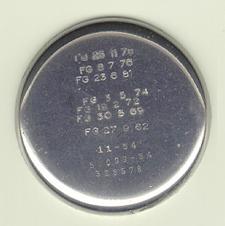
The watches belonging to the French forces were overhauled every year. (In theory, anyway.) After servicing, the casebacks were marked with the letters "FG" which stand for Fin de Garantie (end of warranty) and the date of the next scheduled maintenance. The caseback shown at the right is from an Auricoste Type 20, and shows a series of servicing stamps.
Repair facilities included the Dodane manufacturer in Besançon and various repair units operated by the different service branches. Sometimes there is an engraved "P" on the caseback, which means that the watch had been to the Pechoin workshop in Paris. This workshop had a contract with the French forces and specialized in the repair of aviation timepieces.
The Type 20 and Type 21 had some common features. All were two-button manual-winding flyback chronographs. All had black dials, luminous hands and arabic numerals, a finely-divided seconds chapter at the outer edge of the dial, and bidirectional revolving bezel. All were in cases of approximately 38 mm x 14 mm.
Beyond the basic similarities, however, there was a wide variation in the details of the different watches supplied by each manufacturers, and even different models supplied by the same manufacturer. Many different movements were used. Some watches had two chronograph registers and some had three. Some had a bezel inscribed with the hours, some had a bezel with a simple reference mark. The watches shown below illustrate some of these differences.
Breguet
The Breguet Type 20 is the most famous, and, to collectors, the most valuable of the French military chronographs. Montres Breguet was founded in 1775 by the great inventor and clockmaker Abraham-Louis Breguet (1747-1823), and had its headquarters in Paris until it moved to Switzerland in the 1970s.
The Breguet watchmaking firm had a long history of involvement with aviation industry due to Louis Charles Breguet (1880-1955), who was a pioneer in aeronautics. Louis Breguet was the great-great-grandson of Abraham-Louis Breguet. Louis Breguet developed his first aircraft in 1909 and during World War I his company, Société d'Aviation Louis Breguet, produced about 5,500 Breguet XIV (Br-14) aircraft for the Allied Forces.
 Designed by Louis Breguet in 1916, the innovative Breguet Br-14 was a highly successful biplane used by the French, Belgian and American air services. It was rugged and versatile, and saw service as a reconnaissance aircraft, a bomber, and an ambulance. The Br-14 had a wingspan of 14.36 m and was powered by a Renault V12 engine which gave it a maximum speed of 177 km/h at 2,000 m and a ceiling of 5,800 m. After the war the advanced Breguet XIX made historic long-distance flights across continents and oceans.
Designed by Louis Breguet in 1916, the innovative Breguet Br-14 was a highly successful biplane used by the French, Belgian and American air services. It was rugged and versatile, and saw service as a reconnaissance aircraft, a bomber, and an ambulance. The Br-14 had a wingspan of 14.36 m and was powered by a Renault V12 engine which gave it a maximum speed of 177 km/h at 2,000 m and a ceiling of 5,800 m. After the war the advanced Breguet XIX made historic long-distance flights across continents and oceans.In parallel with the aeronautic achievements, the Breguet watchmaking firm developed aeronautical instruments and aviation chronographs. Their first clients were the American pilots stationed in France, and they were soon followed by Louis Breguet's aircraft firm and many others.
The Breguet Type 20 chronograph was produced in small numbers until it won the official approval of the French services in 1950. From 1954, Breguet was commissioned by the French government to supply the Type 20 to the Air Force, the Naval Air Arm, and the CEV. The Breguet Type 20s used stainless steel cases and screwed case backs.
The standard model for the French Air Force had a 30-minute counter at 3 o'clock and used a Valjoux cal. 22 movement with an added flyback function. (This movement may have been called the Valjoux cal. 222.) The Valjoux cal. 22 was first released in 1914 and was one of the first chronograph movements designed for wristwatches. The 17-jewel rhodium-plated movement is 14''' (31.6 mm, 1''' = 2.2558 mm) and uses a monometalic balance and Breguet balance spring. There were approximately 2000 of this model made. The case back was engraved with "BREGUET TYPE 205101/54" and the serial number and year.
The French Navy ordered a version with a 15-minute register for their pilots. These were engraved with "BREGUET TYPE 20 MARINE NATIONALE ONE AERONAUTIQUE NAVALE" and had an antimagnetic interior shield.
The CEV ordered 500 watches with 2 registers and 50 watches with 3 registers; these were engraved with "CEV" and the serial number. The CEV version had 15-minute registers and bezel engraved with hour markers.
Some pilots purchased personal copies of the Breguet Type 20 and some civilian models were sold. Since they were built over period a of many years there are quite a few variations in style. (Including at least one non-military issue with a silver dial, fixed bezel, and applied indices -- almost unrecognizable but sold as a Type 20 at auction.) Some counterfeit Breguet Type 20s have been seen, usually a Type 20 from a different manufacturer with a redial.
Breguet tried to win new contracts from the military in 1970 but their prices were too high. A second-generation civilian model was produced in the 1970s and 1980s, and has a heavier, polished steel case with squared lugs. This model used a gold-plated 17-jewel 14''' movement.

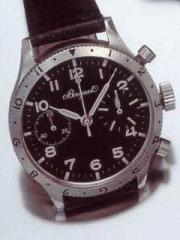
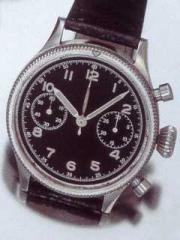
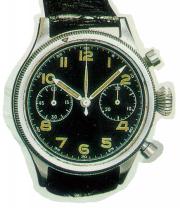
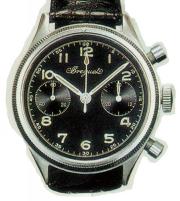
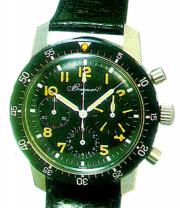
Above are several examples of the Breguet Type 20. Note the different bezels, crowns, and hands. Some of the minutes registers total 15 minutes, some total 30 minutes, and some are enlarged to facilitate reading. The watch on the lower right is a second-generation Breguet Type 20 from the 1970s.
Breguet Type 20 (Lhote and Lassaussois, 34Kb) The watch to the left is one of the rare 3-register models issued to the CEV. Another example of a 1950s 3-register Breguet, part of Gordon Bethune's collection, is shown on page 26 of the Feb/Mar 1999 issue of InSync.
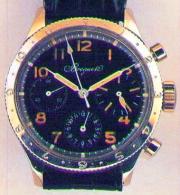
The third-generation Breguet Type 20 chronograph was launched in 1995 and has a fluted caseband and a Lemania self-winding movement.
Vixa
The Vixa Type 20 was built in 1954 with case and movement by Hanhart. The company "Vixa" was named after a late president of Timex Watches France. (Timex had a factory in Besançon until 1960.) Some 4000-5000 Vixa Type 20 chronographs were supplied.
Adolf Hanhart was founded in 1882 and made stopwatches and timing products. The original factory was founded in Diessenhofen, Switzerland; it later moved to Schwenningen, Germany. In 1924 production relocated to Gütenbach, Germany. After the war, the Black Forest was part of the French Occupation Zone, so Hanhart produced chronographs under the Vixa name for the French forces. These deliveries were part of the German reparation payments to France. (Walter Storz [Stowa] provided watches for the French ground forces.) Since the 1960s Hanhart has concentrated on timers and stopwatches but they have recently re-introduced wristwatches to their product line, including a replica of their famous fliegerchronograph.
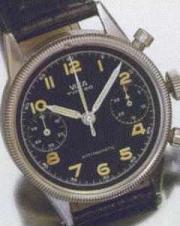

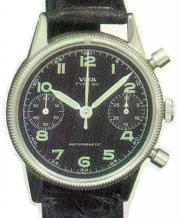
Above are three examples of the Vixa Type 20 from the 1950s. They have a reeded bezel and are marked "Antimagnetic" on the dial. The cases are stainless steel with a screwed caseback, and, at 39 mm, slightly larger than other Type 20s. The watches of the French Air Force were marked with the number "5100 54" and the respective serial numbers.
The Vixa Type 20 chronographs were similar to the Hanhart chronographs of the post-war German Federal Air Force. The movement is a rather large 16''' 17-jewel Hanhart movement, variously described as a cal. 4054 (Antiquorum), a cal. 40 (von Halem), or a cal. 15 (Knirim). The movement is only marked "Germany" (not "Hanhart" or "Vixa"). The Vixa was the only Type 20/21 to use a German movement.
Auricoste
Another manufacturer of the Type 20 chronograph was Auricoste, a specialist in naval clocks, stopwatches, and wristwatches. Auricoste was founded in 1854 by Emile Thomas, a clockmaker, who developed marine chronometers. In 1889 Thomas was succeeded by Joseph Auricoste, and in 1900 Auricoste was awarded a gold medal at the Paris Universal Exhibition. Today Auricoste supplies clock and timekeeping systems for marine applications and has its headquarters in Paris.
Auricoste provided around 2000 Type 20 chronographs under contract and delivered them to the French military between August 1954 and March 1955. The Auricoste Type 20 used Lemania movements that were marked "Auricoste." At least two different movement were used, one being the Auricoste cal. 2040 (Lemania cal. 15TL). The cal. 2040 is a 17-jewel, 15''' movement (33.3 mm x 6.5 mm), 18,000 bph, with a Breguet balance spring and Incabloc shock protection. The Lemania 15TL was introduced in 1940 and was Lemania's first movement to implement the flyback function. Another movement used by Auricoste in the Type 20 was a rhodium-plated 16-jewel, 14''' movement. And at least some movements were delivered with a swan-neck regulator. There were also two case types, one in stainless steel and one a plated base metal case; both used a stainless steel snap-on back.
Two other models were built in small numbers later: a model for the Moroccan and Argentinian air forces and one for the civilian market with a tachymeter scale. These later models were in steel and had a screwed caseback, and were supplied until 1961. The Argentine pilots, who were trained in France, carried these watches in the Falkland War against Britain.
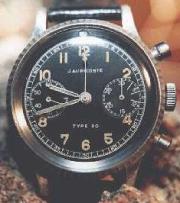
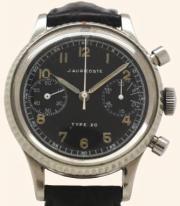
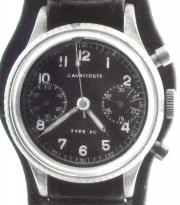


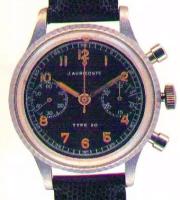
Above are several examples of the Auricoste Type 20. The bidirectional bezel is knurled and has a simple reference mark. The 30-minute register is at 9 o'clock. The watch on the lower right has a screwed back.
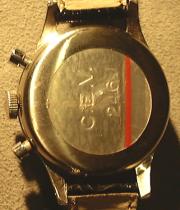
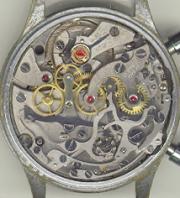
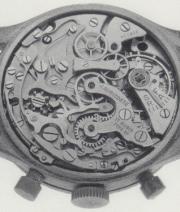
The caseback on the left is marked "C.E.V.," the original owner of this watch. (The back looks a bit funny because it is covered by a clear protection sticker.) This watch does not show any "FG" inspection stamps; perhaps it was kept in storage and not serviced. The center and right pictures show the Auricoste cal. 2040 (Lemania cal. 15TL) movement.
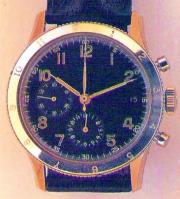 The watch on the left is not a Type 20, but is an interesting flyback chronograph made by Auricoste in the 1950s for the French army. It is difficult to see in this picture, but there is a small window at 3 o'clock for a digital minutes counter. It has a bezel marked in hours, a 12-hour totalizer at 6 o'clock, and a steel case with a screwed back.
The watch on the left is not a Type 20, but is an interesting flyback chronograph made by Auricoste in the 1950s for the French army. It is difficult to see in this picture, but there is a small window at 3 o'clock for a digital minutes counter. It has a bezel marked in hours, a 12-hour totalizer at 6 o'clock, and a steel case with a screwed back.
Dodane and Airain
Dodane was founded by Alphonse Dodane in 1857 in Besançon. They were a long-time specialist in aviation timepieces, having constructed them for the US Army and Signal Corps since World War I. Besides manufacturing watches for the French armed forces, Dodane was a key part of their maintenance and service organization, and did general overhauls on all Type 20 and Type 21 watches in production.
Dodane constructed Type 20 and Type 21 chronographs between 1960 and 1980. (A small series was issued to NATO in the 1970s.) Total production was around 5000 pieces. Dodane used different movements at different times. They started with their own movements and then switched to outside movements including the Valjoux cal. 22 (cal. 222?) and later the Valjoux cal. 720. The change to the Valjoux cal. 720 may have been made with the switch to the Type 21.
All Dodane chronographs had the same stainless steel housing with a screw-back. Generally the caseback was engraved with the Phoenix of the Besançon observatory. Most of the Dodane models had an bezel engraved with the hours in count-down order (opposite of the Breguet direction).

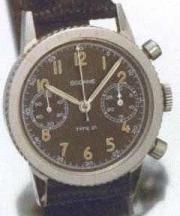

 The watch above, left is a Dodane Type 21 with a black bezel from the 1950s. In the center is a Dodane Type 21 with an unmarked bezel, c. 1955. On the above, right is Dodane Type 21, c. 1965. Directly to the right is a Dodane Type 21, c. 1974.
The watch above, left is a Dodane Type 21 with a black bezel from the 1950s. In the center is a Dodane Type 21 with an unmarked bezel, c. 1955. On the above, right is Dodane Type 21, c. 1965. Directly to the right is a Dodane Type 21, c. 1974. Another example of the Dodane Type 21 from 1968 is shown in A Concise Guide to Military Timepieces on page 156-157, with a photo of the front and back. The back is marked with "All Steel," "Water protected," "Antimagnetic," and several "FG" service marks.
Most of the chronographs made by Dodane were two-register models. According to Knirim, these were differently marked: Dodane, Airain, Chronograph Militaire, and Chronofix.
Some 50 3-register models were built for French helicopter pilots. These are more difficult to find than the 3-register Breguet (of which 50 were also made) since they were more of a trial version than an official order.
Some copies were also supplied to Morocco.
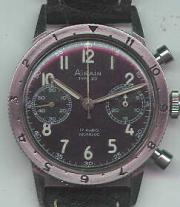
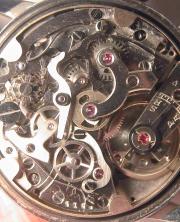
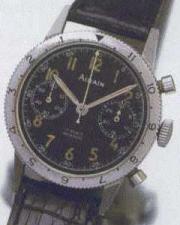
Above left and center is an Airain Type 20 and its Valjoux cal. 22 movement from the 1950s. On the right is an Airain, c. 1955; its movement is described as a 14''', 17-jewel movement with a monometallic balance, shock protection, and a Breguet balance spring.
Postscript
The Type 20 chronograph is no longer used by the French armed forces. New chronographs were evaluated at the beginning of the 1970s. In 1973 the Pechoin workshops supplied a set of prototypes using Valjoux movements, some labeled Type 21 and some labeled Type 22, but neither were officially accepted. Since that time, chronographs from many manufacturers have been tested and small procurements have been made. At one time the Air Force purchased Yema quartz chronographs; Breitling Plutons were selected for the Naval pilots; most service branches experimented with Casio G-Shocks. But all of these watches were commercially available. The time when watches were a special military instrument is past.
References
1. Antiquorum, Auction Catalogs, Geneva: April 1999; Hong Kong, June 1999.
2. Auricoste web site, http://www.auricoste.fr/
3. Breguet web site, http://www.breguet.com/
4. Stephan Ciejka and Konrad Knirim, "Militäruhren: Uhren der französischen Streitkräfte," Klassik Uhren, December 1996, Ebner Verlag, Ulm, Germany.
5. Michael Friedberg, "That Elusive Type XX," TimeZone Archives, April 29, 1998.
6. Hanhart web site, http://www.hanhart.com and http://www.hanhartusa.com.
7. Konrad Knirim, Militäruhren: Die Uhren der deutschen Streitkräfte von 1870 bis 1990, Peter Pomp, Germany.
8. Gerd-R. Lang and Reinhard Meis, Chronograph Wristwatches: To Stop Time, Schiffer Publishing, Atglen PA, 1993.
9. Lemania, "Calibre 15TL parts catalog," 1944.
10. Gilles Lhote and Jean Lassaussois, The World of Watches, Chartwell Book, Edison NJ, 1995.
11. L'Orologio, no. 60, February 1998, pp. 149-155, Argò, Rome.
12. Z. M. Wesolowski, A Concise Guide to Military Timepieces: 1880-1990, Windrow & Greene Ltd., London, 1996.
Photograph credits and copyrights belong to:
Antiquorum, Breguet, Danny (TimeZone), Explor'heure (Paris), Franco (TimeZone),
Lang and Meis, Lhote and Lassaussois, L'Orologio, Time to Watch (Z rich),
Clemens von Halem (Munich).
Last updated: 9/23/99